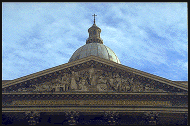A Bit of HistoryLouis XV vowed in 1744 that if he recoverd from an illness he would replace the ruined church of St-Genèvieve Abbey with an edifice to the glory of the patron saint of Paris: St-Genèvieve. The Marquis of Marigny was entrusted with the fulfillment of the vow after the king regained his health. The protégé of Marigny - Soufflot - was charged with the plans.
Thus began the construction of the Panthéon. Situated on the Montagne St-Genèvieve, it had a commanding view of the city. The overall design was that of a Greek cross with a massive portico of corinthian columns. Its ambitious lines called for a vast buidling 110 metres long by 84 metres wide, and 83 metres high. No less vast was its crypt.
The foundations were laid in 1758, but due to financial difficulties, it was only completed after Soufflot's death (1780) by his student, Rondelet, in 1789. No sooner completed, than the Revolutionaly government changed its mission from that of a church to that of a mausoleum for the remains of great Frenchmen.
Twice since then it has reverted to being a church, only to become again a temple to the great men of France. Among those buried in its necropolis are Voltaire, Rousseau, Mirabeau, Marat, Victor Hugo, Emile Zola, and Soufflot its architect.
The remains of Jean Moulin - hero of the French Resistence during the Second World War - were moved here by Charles de Gaulle.
Thus began the construction of the Panthéon. Situated on the Montagne St-Genèvieve, it had a commanding view of the city. The overall design was that of a Greek cross with a massive portico of corinthian columns. Its ambitious lines called for a vast buidling 110 metres long by 84 metres wide, and 83 metres high. No less vast was its crypt.
The foundations were laid in 1758, but due to financial difficulties, it was only completed after Soufflot's death (1780) by his student, Rondelet, in 1789. No sooner completed, than the Revolutionaly government changed its mission from that of a church to that of a mausoleum for the remains of great Frenchmen.
Twice since then it has reverted to being a church, only to become again a temple to the great men of France. Among those buried in its necropolis are Voltaire, Rousseau, Mirabeau, Marat, Victor Hugo, Emile Zola, and Soufflot its architect.
The remains of Jean Moulin - hero of the French Resistence during the Second World War - were moved here by Charles de Gaulle.


2. Aux Grands Hommes La Patrie Reconnaissante - To Great Men To Whom The Country is Indebted.



0 Comments:
Post a Comment
<< Home